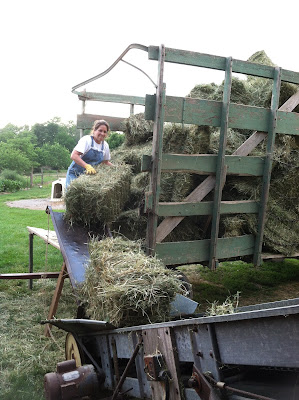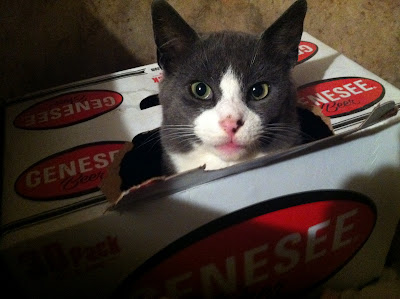At Double D Dairy, all of the hay we feed our cows and heifers is grown and harvested on the farm. We grow mostly alfalfa hay, but also bale some oats hay and grass hay. Below is a picture of oat plants. It makes great hay for growing heifers and dry cows but it sure can be dusty, and the little oats stick to your clothes!
| Oat plants |
Alfalfa is considered a legume. Legumes produce seeds that are contained in pods. Other members of the legume family include peas, beans, lentils, peanuts and locust trees. Alfalfa is rich in protein, calcium, magnesium, potassium and many vitamins and minerals. Alfalfa is drought tolerant, it's roots can reach down almost 50 feet into the ground! It can also be cut over and over again. A typical alfalfa stand at Double D's is cut five times per year and is active for three years.
 |
| Alfalfa plants in bloom |
About a month ago we finished harvesting the first cutting of our alfalfa stands. Most of the forage went into the silo as haylage. Once the silo was full, we made what was left into hay. The trick to making good alfalfa hay is cutting the alfalfa at the perfect stage of maturity, when the nutrient content is highest in the plant. Another key to making good quality hay is baling it when the moisture content is just right. If the hay is too wet it will heat up and mold in the barn. If the hay is too dry the small leaves, which contain the most nutrients, will fall off the stem before they can be picked up by the baler. If the hay is cut and it rains before we can bale, the quality of the hay will decrease.
| An alfalfa field at Double D's, notice the cut plants in the foreground
|
Needless to say when we cut hay, everybody crosses their fingers. We pray that it won't rain, there won't be any equipment break downs and that we have enough help to get the hay baled and put in the barn in good time. Since the purchase of our 1586 tractor and our new baler we are able to make hay much faster than with the old tractor and baler. This means we need plenty of help in the barn unloading wagons so Rick isn't waiting in the field for empty wagons to fill!
 |
| Kim frantically working to keep her hubby happy |
Each wagon holds about 115 bales of hay. When there is an adequate amount of help a load of hay can be unloaded in 15 minutes or less.
 |
| The elevator carrying bales up to the mow |
 |
| Jake trying to catch a bale coming off the elevator |
 |
| Susie giving the thumbs up |
Baling hay can be a hot, sweaty, unpleasant job. At Double D's we always make sure it's a party!
 |
| Susie, John, Brett, Kim, and Jake |
And of course, we all enjoy a cold one after all the work is done....
 |
| Empty beer cases make good kitty houses |

























